I didn’t provide any coverage of the gatekeepers in the book “Fires, Farms and Forests”, as I had limited information at the time. And yet, you couldn’t tell a story about Surrey Hills and AFH without mentioning the gatekeepers.
Back in the 1950s, the Ridgley Highway didn’t exist. You could only get to Waratah via the Murchison Highway through the Hellyer Gorge and then onto Guildford Junction. When AFH began constructing their roads, they started the main road at Hampshire and went south. At the same time, they also started at east of Guildford and went north. When the roads joined, everyone wanted to drive through Surrey Hills. On the way, they could shoot game, collect firewood and anything else that was detrimental to the landowner’s interests. Also, the road pavements were only one lane, and it was dangerous having unlimited and uncontrolled access competing with the log trucks on the roads. Gates were set up and manned full-time by gatekeepers to control access to AFH employees and contractors.
Initially, there was a gate at Hampshire. Basil Murray was the first gatekeeper. Other gatekeepers were Col Dudfield, “Putt” Hawthorne, Ken Walters, Murray Wilcox, Noel “Yogi” Wells, and Merv Pyke. For some, roads were named in their honour. Basils Road after Basil Murray[1] and Dudfield Road after Col. The gatehouse was shifted closer to the Ridgley Highway in the 1980s and closed in the mid-1990s after the Hampshire mill came into operation.
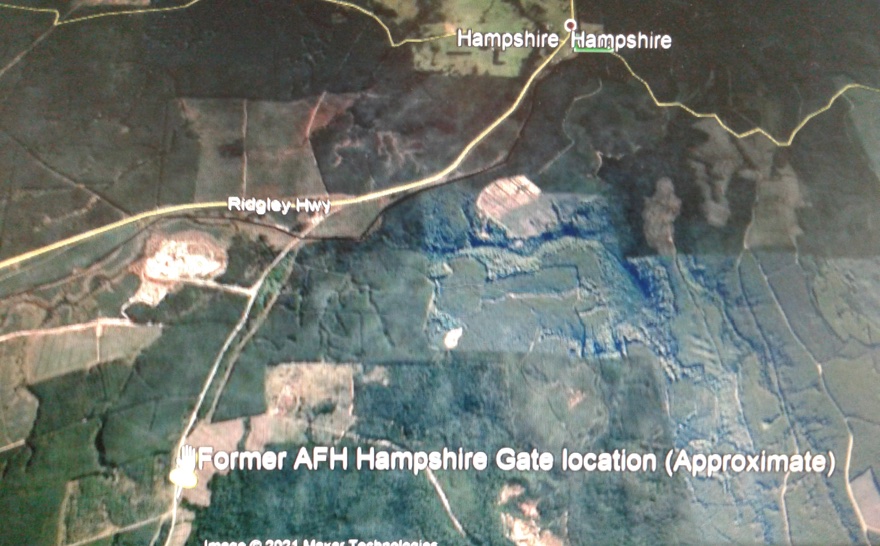
After a road was constructed across Talbots Lagoon dam wall in 1963, linking Guildford Junction to the road network on Surrey Hills, a gate and gatekeeper were placed at Guildford. Ken Crawford was the first gatekeeper. Other gatekeepers were Basil Murray, Norm Hodge and David “Nappy” Goninon. The gatehouse closed in 1982.
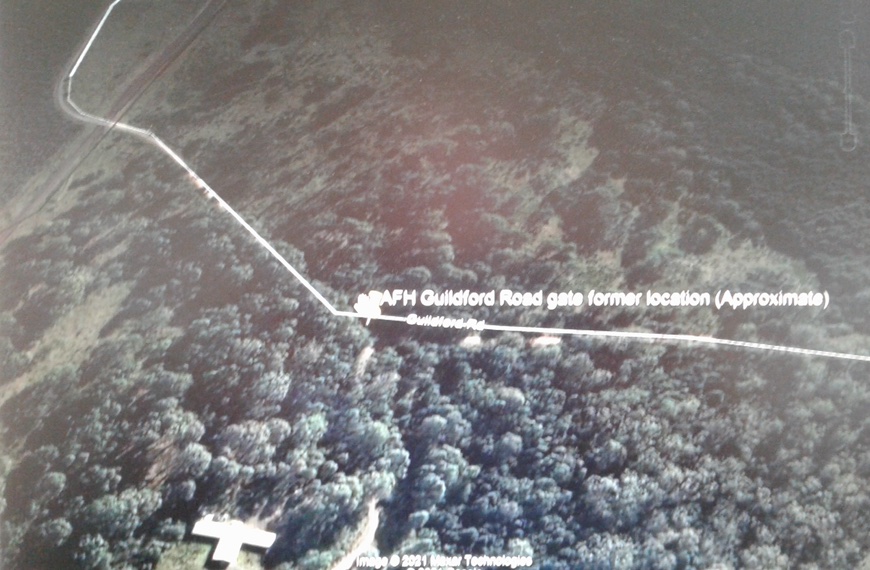
When the Murchison Highway was constructed to Tullah in 1963, it went past Moory Road and the gravel pit near the southern end of Surrey Hills. A gatehouse was put in place to stop unwanted and illegal activities from people entering Surrey Hills using this new access point. Noel “Yogi” Wells was the gatekeeper for many years until it closed in 1984.
Jodie Hawthorne has written this month’s guest blog. It is a beautiful story about her grandfather Ernest “Putt” Hawthorne, the Hampshire gatekeeper during the 1970s and 80s. She reflects on her visits to Surrey Hills with her Pa in her younger days. Jodie is the mother of two, a teacher, writer and transcriber. She is the founder of King River Press and the Van Diemen’s Land Facebook page.
If anyone has any more information to add to this important history of Surrey Hills, I am particularly interested in writing a similar story on the other gatekeepers. If there are any descendants who have similar memories like Jodie’s, and would like to share a story, please leave a comment or contact me directly through the web site.
Our Pa, Ernest “Putt” Hawthorne, was quite well known around the northwest coast of Tasmania. Born in 1914, he was one of 10 kids and grew up in Somerset. He married our nan Dulcie Hoare and from then on in the couple were known as “Putt and Dolly”. They only had two children. My dad, Peter, is their only son. Putt was a charismatic, sociable, capable, curious, no-nonsense sort of man who enjoyed many interests and pursuits over his lifetime. In his younger days, he played footy and continued to be a strong local supporter thereafter. He was a skilled and knowledgeable fisherman and bushman. Some of his occupations included labourer, soldier, farmer, bookmaker, publican, horse owner/trainer and pigeon breeder.
In the 70s and 80s, Pa was a gatekeeper on the Hampshire “pulp gates” – the northern entry point into the Surrey Hills Estate which fueled the APPM pulp and papermill in Burnie. Throughout those years, “the gates” and memories connected to the place became a very important part of our lives – an unforgettable chapter in our family history. The hour or so trip down there would start at Nan and Pa’s old, rented farmhouse in Romaine. After packing the ute, we’d head off along Ridgley Highway, dropping in at Sargents store for essential supplies such as fresh milk and bread, butter, batteries, newspapers, Quick-Eze, Champion Ruby, Log Cabin, Tally-Ho, pipe cleaners and one Chomp bar for me. The next pitstop would be a quick refuel at the roadhouse opposite, and we’d be on our way.
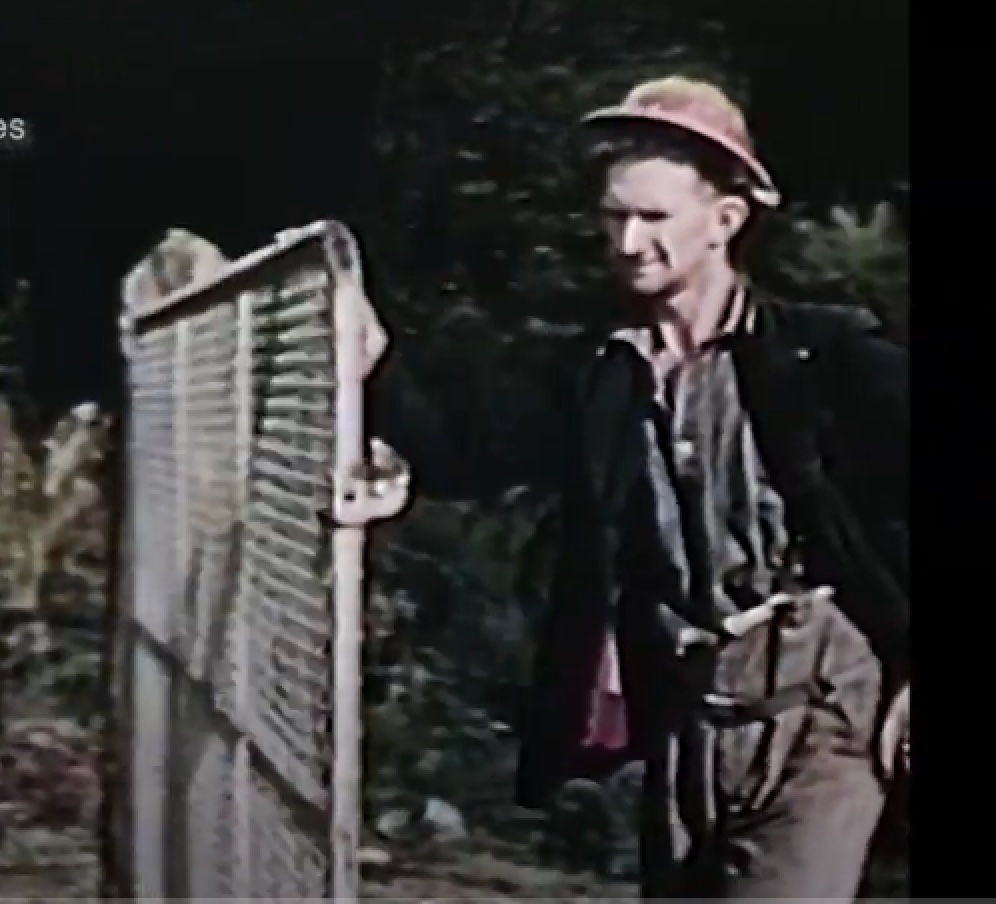
Usually, I would stay awake for the trip, counting down the many familiar landmarks, eagerly anticipating our arrival. But sometimes I would drift off in the warmth of the ute, only to be gently awoken by the clicking of an indicator, the left turn into Guildford Road or from the sudden terrain change from sealed to gravel. As we came closer to the gates, St Valentine’s Peak in the distance, there was a large, faded fire warning sign on the right that indicated we were only minutes away. As soon as the ute pulled up, I would firstly take myself on a tour around the interior of the gatehouse and marvel at all the rustic yet innovate extensions and improvements Pa had made since our last visit.
In the early years, the gatehouse was not much more than a rough, bachelor shack. Prior to the upgrade of a generator and electricity, the only light after sunset was that of the moon, candles and a couple of sparingly used torches and kerosene lamps. Entertainment wise there were the newspapers, novels, colouring-books, a radio, playing cards and occasionally Pa would hook up his little black and white TV to a car battery. Communication was via CB radio. Water was sourced from a small tank out the back or brought in from the farmhouse. Bottled gas was used for cooking. I remember one time Pa proudly taking Nan and I out the back to his upgraded outhouse with its drop-hole toilet, demonstrating a new pully flusher and some organic ways he found to reduce any odour, whilst also pointing out to me that the spiders and their webs were no longer.
Pa’s gatekeeper position required him to be available 24/7 when he was onsite. He kept a logbook of the rego plates and the times of vehicles coming in and out. Pa and whichever gatekeeper was on the Guildford end would communicate any important matters over the radio or notes passed through from other drivers. The road through was not only used by workers to access the forests, but also as a shortcut to the West Coast. During the daytime, there was the usual flow of roadwork, transport and log trucks, pulp vehicles, fishermen and personal friends of the landowners. Late at night or very early morning we’d occasionally hear a vehicle pull up. Pa would get up, engage in a short conversation, unchain and open the gates, wave them through, close and rechain the gates and then go back to bed until the next one rolled up or morning came. Every now and again you’d hear stories of somebody breaking in somewhere, stealing something, crashing down the gates or slipping through them.
Over those years, the more time my nan, Dolly spent at the gatehouse, the more charming it became. They had a little veggie garden out the back and Nan planted pansies out the front alongside the pathway that led to the gatehouse front door. The transformation of the place was so obvious that many of the blokes who popped in for a yarn and a cuppa would comment on the “lady’s touch”, to which Pa would carry on as if he hadn’t heard them. Putt wasn’t really the sort of bloke who would freely express emotions, but his efforts of extending and upgrading the gatehouse and his personal shack into increasingly livable and family-friendly spaces was ample evidence of his desire to entice us to visit and stay there when we could.
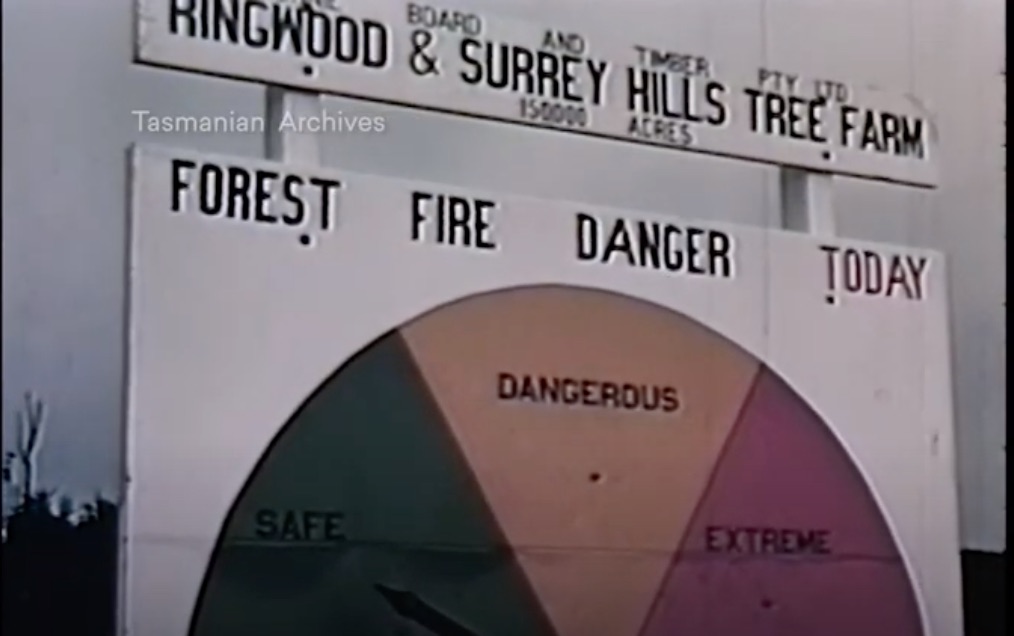
We enjoyed many a discovery drive around the area. Pa would take us on short trips along the newest roads and to view the progress on new growth plantations, adding commentary of whatever he’d learned about the different Eucalyptus species, their successes and failures and any other stories he thought were of interest. After his stint on the gates came to end, luckily Pa and the family were still able to visit and stay at the personal shack he built deep down in the Surrey Hills bush. Yogi Wells, the new gatekeeper and a friend of Pa’s, would then be the one to open the gates and wave through our family convoys. On a couple of family reunion trips, we ventured out to Talbots Lagoon where Pa reeled in some nice sized brown and rainbow trout which we cooked then and there in foil on an open fire. Pa’s time as keeper of “the gates” and the many other stories yet to be told are not just personal, they are very much part of a broader culture and an important, rich aspect of Tasmanian folk history. Putt spent the remainder of his best years in the bush. He passed away in 1991 and was reunited with Dolly in 1999. They are both sadly missed and fondly remembered.
[1] Basil passed away in 1971. More information about Basil can be found at http://nichaygarth.com/index.php/2018/12/08/basil-and-cutter-murray-tigers-and-other-travelling-tales/
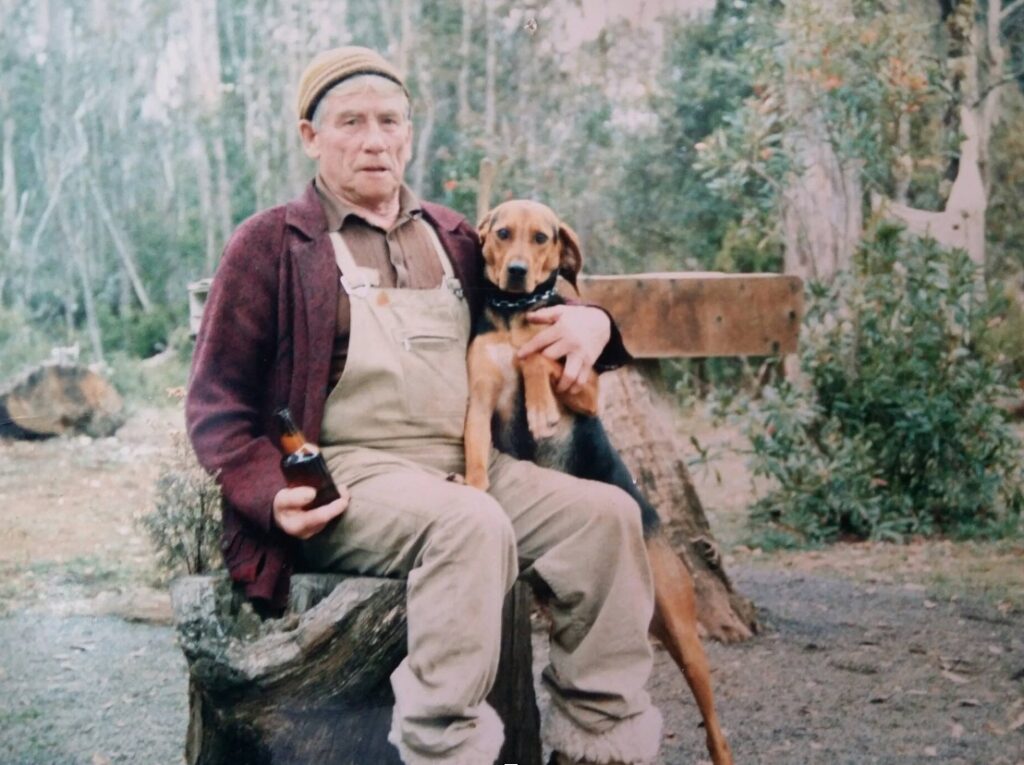
At least once a week I travelled the road and often I was given a key to pass through the Moorey gate. One day I was asked if I made a copy of the key for personal use. No, I said. Somebody made copies for people, working in Rosebery and sold them for $10. The company afterwards had keys, that you could copy only with written permission.
I obtained a key and returned it when I retired from my job at the Emu Bay Railway.
Unknown person opening gate is Charlie Wilson (my father)
Awesome thanks Lloyd. I didn’t recognise him.
During the short stint my father spent with the APPM, (Dec. ’55 until Dec. ’56,) he was never employed as a permanent gatekeeper but periodically would provide relief for a day or two if required for various reasons. To my knowledge he never ever stayed overnight at the gates but would return home to Guildford for the night and then travel back next morning.
When thinking about Basil Murray, there are a couple of memories which spring vividly to mind. One being when returning to Guildford late at night either from a football match or visiting relatives etc.the gate would, more often than not, be locked and Basil would be in bed. It was often my job to enter the camp, identify myself, fiddle around for the key in the dark and then unlock the gate. The one thing you never did was “slam” the door, otherwise you’d hear “Don’t slam that door..I’ve told you before..”
I can also remember Basil’s brother Ern or “Horse” as he was more commonly known. Horse was single, worked for the EBR as a fettler, and lived in the single men’s camps. He also had either an artificial leg or a stiff leg which he seemed to manage with quite well.
I can remember also Dad moving the family to Burnie in late 1960. We had trucked our furniture to Burnie quite early on the Saturday morning then Dad returned to load the truck with wood that he had cut and stacked in the yard for our own use. Now, Dad had known Basil for many years, from early days of snaring etc. but when he arrived at the gates with the load of wood, Basil refused to let him continue as he was to see that no wood was to leave AFH property without permission. I suppose Basil was “technically” correct but it didn’t do much for Dad’s mood that day. I cannot remember if Dad had to contact Ted Crisp or Basil relented but I do know that the issue was solved and we continued on with our load of wood to Burnie.
Finally, I can remember that Dad and other “oldtimers” of Guildford have said that Basil was as quiet as a mouse when making his way through the bush and would hardly break a twig. Hence the name “Mouse” Murray, out of earshot, of course!
Hi Lloyd,
Thanks for sharing these stories about Basil and the goings on on the Guildford end. I did have a bit of a chuckle. He certain sounded like quite a character. I feel Basil’s is a story that also would be of value. Hope that your memory brings a family member forward to write up a blog post or we can collate a collection of these memories for current and future generations to enjoy.
Cheers,
Jodie
Hi there,
Thanks to Lloyd Wilson I now have a copy of all the above and was very interested to read some of what Jodie had written. I am a mate of Lloyds and was a good mate of Putt, Yogi, Merv, and a few others.
I would love to be able to chat with Jodie or yourself, about my experiences at Surrey Hills, and particularly with Putt. I am mid 70’s now and started my first trip to Talbots in about 1974.
There was a pretty exclusive ‘clique’ of blokes who clubbed together with Putt at his camp on Wey Road. During all the fish and game seasons I was a regular visitor and lodger at the camp spending many nights with Putt and the others around the open, but covered, campfire. Boy we had much fun and the amber fluid and whiskey flowed profusely at all times.
Campfire stories abounded from blokes like Billy and Peter Winskill, Ernie Bonney, and quite a few others. Simply fascinating. Can’t be 100% sure but I believe the photo of Putt and Dixie was taken at the Wey Road camp, where on Melbourne Cup day, Putt would run a bookies board on the side of the shack.
Thanks for the history.
Mick Davis
Hi Mick,
Thank you so much for commenting and sharing some of your memories. Would love to hear more about your times spent with our Pa. I didn’t know the name of the road so thanks for that. Do you remember Pa had some smoking sheds set up there? He smoked fish and meats.
The photo was one from the family collection. I think it may have come from my aunt? I do believe you are right that it was taken at the camp. Was an amazing set up Pa had there. Great time to grow up for sure. I will send you an email to follow up.
Thank you again!
Jodie